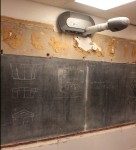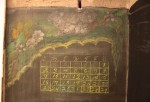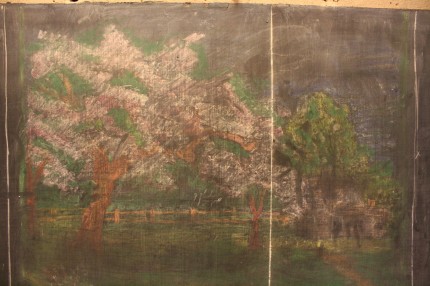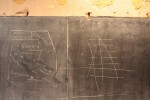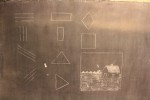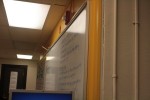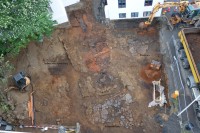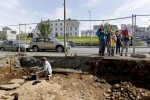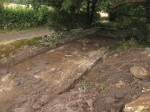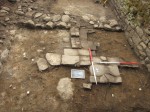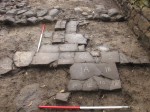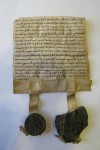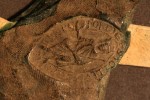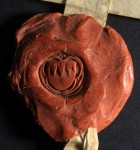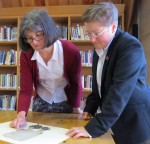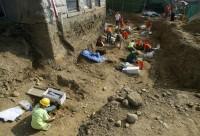 The remains of more than 100 African Americans buried in the Colored Burial Ground in Newburgh, New York, that have been languishing in storage for seven years due to the neglect of the City Council are finally getting some attention. The bones were unearthed in 2008 by archaeological contractors Landmark Archaeology who surveyed the site of the former Broadway School before it was renovated into the city court building. The city agreed to pay $75,400 for the excavation and the archaeology report necessary for reburial of the remains. Only $52,000 was paid because they had raised the funds through a bond. The remaining $23,000 for the report was supposed to come out of the general fund, but the Newburgh City Council never authorized payment. The bones were stuck in the limbo of storage in a climate-controlled facility at SUNY New Paltz while the years passed. Today, the City Council will finally vote on a resolution to pay Landmark Archaeology and get the ball rolling on a the long-denied dignified reburial of the human remains.
The remains of more than 100 African Americans buried in the Colored Burial Ground in Newburgh, New York, that have been languishing in storage for seven years due to the neglect of the City Council are finally getting some attention. The bones were unearthed in 2008 by archaeological contractors Landmark Archaeology who surveyed the site of the former Broadway School before it was renovated into the city court building. The city agreed to pay $75,400 for the excavation and the archaeology report necessary for reburial of the remains. Only $52,000 was paid because they had raised the funds through a bond. The remaining $23,000 for the report was supposed to come out of the general fund, but the Newburgh City Council never authorized payment. The bones were stuck in the limbo of storage in a climate-controlled facility at SUNY New Paltz while the years passed. Today, the City Council will finally vote on a resolution to pay Landmark Archaeology and get the ball rolling on a the long-denied dignified reburial of the human remains.
This is one in a long line of indignities inflicted on the bodies of deceased black citizens of Newburgh. The Colored Burial Ground, like its equivalents in every other city in the United States, was in an isolated, undeveloped area of the town when it was first founded in around 1832. What was out of the way farmland in 1832, however, was rapidly industrializing by the late 1860s. An oilcloth factory was built on the east and north borders of the cemetery. A new road, Robinson Avenue, was built to its immediate west in 1873. By 1869 foot and wagon traffic had encroached on the burial ground to such a degree that erosion exposed some of the bodies. When Robinson Avenue was constructed, they found remains in their way and moved them to the Alms House Cemetery.
In 1905, the oilcloth factory was demolished and both its property and the burial ground were slated for construction of a new elementary school, the Broadway School. This time the disinterred remains were moved to the colored section of Woodlawn Cemetery and nothing of the cemetery above ground — gravestones, monuments — remained. If there was an effort to fully clear the Colored Burial Ground and remove all the remains to proper graves, they royally half-assed it, clearing some of the area they wanted to use and washing their hands of the rest, even constructing the very building directly on top of some of the bodies still in their graves. The 2008 excavation found graves cut into by utility lines, others missing the sidewalk by mere inches. There were skeletons literally sticking out of the walls.
Here’s a description of the approach taken in the July 3rd, 1908 issue of The Newburgh Democrat & Register newspaper:
It was a grewsome [sic] sight that was observed at the grounds now being excavated for the foundation of the new Grammar School Building, on Broadway at the corner of Robinson Avenue, last evening by a Democratic representative.
There was a procession of boys marching to the unmusical melody furnished by the beating of a tin pan with a stick. At the front and head was the leader, bearing aloft on a piece of pine scantling what had at one time been the skull of a human being.
When the oil cloth factory was removed from the site on which excavation is now in progress two or three years, in clearing up the debris and grading down the grounds to make the place look presentable, a number of human bones were found, hence it was not surprising that since the men had been excavating to a general depth over a tract of ground that other bones should be found by laborers. It was one of the skulls thus unearthed that the boy had taken from the box into which pieces were thrown and with the general disregard boys have for things of a serious character had started in to head a parade with it. […]
Yesterday there was unearthed a box containing the remains of a person who had been buried with his boots and work clothes on. As soon as the air struck the remains everything except the boots crumbled to dust. Last evening there was another box partially exposed to view at the grounds. This will doubtless be unearthed this morning during the day. The bodies that were left in the ground after the general transfer of remains to Woodlawn were those of persons whose graves had not been marked and consequently no investigation was made as to their whereabouts.
More than a century later, with the defunct Broadway School about to be converted into the city courthouse, the extent of earlier neglect became clear when Landmark Archaeology’s excavation revealed more than 100 graves to the west and northwest of the courthouse. They were in seven quite even rows, burials on an east-west axis, feet pointing east, as is traditional in the Christian religion. This is the first indication of the original configuration of the cemetery.
One of the rows continues beyond the property western boundary of the school/courthouse, which suggests there may be more remains to be found heading west beneath Robinson Avenue that were ignored during construction of the road. It’s also likely that the rows continued north under what is now the courthouse parking lot. Archaeologists weren’t able to remove all of the remains; the ones pinned underneath the courthouse walls couldn’t be moved. There could well be more remains underneath the bulk of the building too; we only know about the ones that were findable along the edges.
Unfortunately there are very few extant records that can tell us anything about the Newburgh Colored Burial Ground, or about the African American community of Newburgh in the 19th century, for that matter. Based on census data, we know that there were 148 free “colored” people living in Newburgh in 1822. (New York profited mightily from slavery and it was legal for decades after the neighboring New England states had outlawed it.) There were two black churches near the cemetery, but there no associated burial records have survived, so we don’t know if the cemetery was associated with a specific church, was privately owned or a segregated cemetery for the poor. Burial permits were not required by the state until 1866, so the few records we do have of burials in the graveyard date to 1866 and 1867. It didn’t even appear on a map (that we know of) until 1869 when the City Surveyor marked the spot as the “Colored Burial Ground” in his survey of the area before the construction of Robinson Avenue.
Analysis of human remains and artifacts found at the cemetery, therefore, will fill blanks in a historical record that is all but devoid of information about the cemetery and the black citizens of Newburgh. Once the report is completed and filed, the City Council will have to figure out where and how to reinter the remains. They may even build a memorial in the courthouse parking lot unceremoniously plonked on top of the dead. After being treated with such callousness for 150 years, they’ve earned a little care and respect.
